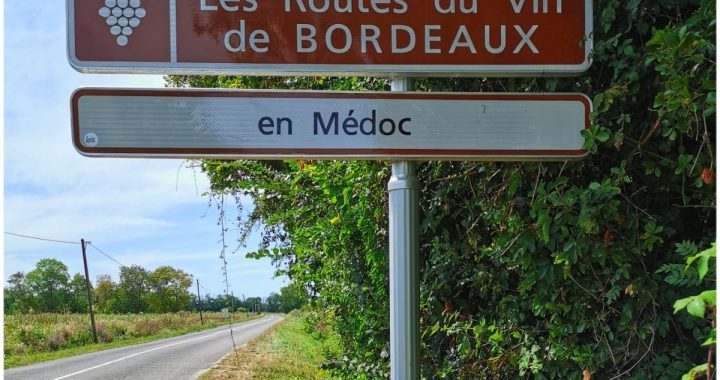Bordeaux is one of the most famous wine region in the world, it is a wine regions with a rich history with a wide range of different wine styles that is a benchmark where other wine regions in the world aspire to be. Unlike the other famous wine region in France Burgundy, Bordeaux wines are primarily blends and are rarely single varietal, this allows the wine maker to make (blend) the best possible wine, mitigating (or reducing) the impact of vintage variation due to external factors such as weather.
Bordeaux has a rich and interesting history, some highlights include:
- Bordeaux was under English rule for a long period of time; as the English used Bordeaux as a port to ship wine back to England
- There is an Bordeaux 1855 Classification that was used during the Paris Universal Exhibition produced by the Bordeaux Chamber of Commerce that produced a list of the best red wines from Medoc and white wines from Sauternes; this ranking has stayed the same since that classification (except for one modification) and remains today as-is, which some people have questioned if it is still a good representation of the Bordeaux Chateau ranking, considering that this classification excludes significant areas of Bordeaux such as the Bordeaux Right-Bank (consisting of famous areas such as Saint-Emilion and Pomerol), there is a good chance you have heard of this classification without knowing it is part of this unchanged ranking since 1855; as this ranking consists of five rankings from First Growth (highest) to Fifth Growth
- Since the Bordeaux 1855 Classifications, other sub-regions in Bordeaux such as Saint-Emilion have created their own classifications, but the confusing aspect of this of certain Bordeaux Right-Bank chateaus classification is not aligned to that of the Bordeaux Left-Bank chateau; the naming and ranking of these two classifications are different and hence is hard (or impossible) to do a direct comparison between an Bordeaux Left-Bank chateau to an Bordeaux Right-Bank chateau
- This delineation between Bordeaux Left-Bank and Bordeaux Right-Bank is based on the Gironde River, when viewing an topological map with north pointing upwards, the area to the left of the Gironde River is known as the Bordeaux Left-Bank and the right of the Gironde River is the Bordeaux Right-Bank; however this general classification gets confusing as the river splits into the River Dordogne and River Garonne at Entre-Deux-Mers where some of the region on the “right side” of the River Garonne is deemed Bordeaux Left-Bank
Bordeaux city, the heart of the Bordeaux wine region is an historical and beautiful medieval city, making Bordeaux one of the best wine regions in the world where you have a true end-to-end experience from great wine makers and vineyards, restaurants and also an historical city to explore too.
- Climate: Moderate Maritime Climate, the Atlantic is a huge influence of the region with the Gulf Stream providing a warm moderating effect; the Atlantic also brings in severe storms but the Bordeaux region is protected by both the Landes Forest and the sand dunes. With this combination, there is a long growing season, at times well into October hence there is rarely any problems with grapes not ripening.
- Grapes: The main black varieties are Cabernet Sauvignon, Cabernet Franc, Merlot and Petit Verdot; with the white varieties been Semillon, Sauvignon Blanc and Muscadelle. There is a term that is used widely called “(Red) Bordeaux blend” which refers to the blend of Cabernet Sauvignon and Merlot with varying percentages and mostly with smaller percentages of the other black grape varieties. In general, due to the terroir, the Bordeaux Left-Bank is generally comprised of clay and are famous for their Cabernet Sauvignon blend; whilst on the Bordeaux Right-Bank is generally comprised of well-drained gravel and limestone soils are famous for their Merlot blend.
- Wine Style: Bordeaux is a large wine region (second largest in France) and depending on the area with Bordeaux there are different wine styles; in general they can be categorised by
- Bordeaux Left-Bank: Cabernet Sauvignon based blend, that is of fuller body with grippy tannins, oaked and age worthy
- Bordeaux Right-Bank: Merlot based blend, not as fully body as their Left-Bank cousin and more red fruit in flavour. However there are some famous chateau using a Merlot based blend that can reproduce the same intense flavours and body as their Left-Bank cousins; these wines from these chateaus are not part of the 1855 Classification but are more sort after than their First Growth cousins in the Left-Bank (such as Château Pétrus and Château Le Pin)
- Sauternes: This is an area in the south of Bordeaux famous for their Semillion based sweet dessert wine affected by “noble rot” (botrytis) using the passérillage wine making method
- Size and Yield: Bordeaux has a total of approx. 120,000 hectares under vine1
Winery
Bordeaux wine makers, like most old world wine regions do not have a walk-in cellar door for you to do wine tastings. For wine makers that do have a walk-in cellar door they will have a sign outside their property advertising this, however the two ways I recommend to do a wine tastings are;
- Pre-book a wine tasting and tour on the wine makers website, most of the large wine makers (such as First Growths) will have an “wine experience”; I have joined the Chateau Mouton wine tour which you book and pay online, which includes a tour of their winery, artwork museum and finally a tasting (including Mouton). You will need to book well in advance as these wine tours (especially for First Growths) are very popular (I had tried to book Château Margaux a month before my trip to Bordeaux and they were full already!)
- The local tourist office will have a list of winery that are have an “open day” for walk-in visits; I had used this service in the Saint Emilion wine region, I physically went to the tourist office (which is good as you can ask additional questions) or you can check-out their website
Here are some of the wineries that I had visited
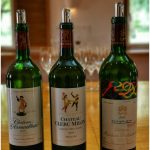 Château Mouton Rothschild (map) (Pauillac) - One of the First Growths (actually was not originally a First Growth and is the only Chateau to have ever been promoted!). Mouton is famous for their different wine label each year, where they have an artist create an artwork which becomes their wine label for that year. As part of the wine tour, besides seeing their wine making and maturation facilities, you will also visit their museum which houses the original artwork that inspired the wine label; and you get to wine taste some Mouton at the end of the tour. A little pricey, but I think well worth it!
Château Mouton Rothschild (map) (Pauillac) - One of the First Growths (actually was not originally a First Growth and is the only Chateau to have ever been promoted!). Mouton is famous for their different wine label each year, where they have an artist create an artwork which becomes their wine label for that year. As part of the wine tour, besides seeing their wine making and maturation facilities, you will also visit their museum which houses the original artwork that inspired the wine label; and you get to wine taste some Mouton at the end of the tour. A little pricey, but I think well worth it!- Château Guiraud (map) (Sauternes) - A famous sweet wine maker located in the famous Sauternes region next to the equally famous Château d'Yquem. Found out from the local tourist office that they had an open day the day I was visiting Sauternes, and joined their wine tour; very interesting and very good as they are fully organic.
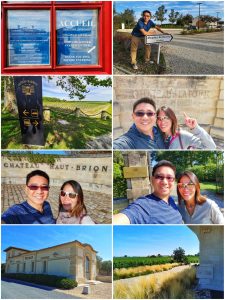 Another suggestion is to visit all the red variety First Growths of the Bordeaux 1855 Classification (Château Lafite Rothschild, Château Mouton Rothschild, Château Margaux, Château Latour, Château Haut-Brion - they are relatively close to each other with the exemption of Château Haut-Brion) and the best white variety from the Bordeaux 1855 Classification of Château d'Yquem (which is further away in Sauternes); take a selfie at the front gate / entrance of each! But don’t forget the other famous wineries (Château) that are not part of the Bordeaux 1855 Classification such as Château Pétrus and Château Le Pin in Saint-Emilion!
Another suggestion is to visit all the red variety First Growths of the Bordeaux 1855 Classification (Château Lafite Rothschild, Château Mouton Rothschild, Château Margaux, Château Latour, Château Haut-Brion - they are relatively close to each other with the exemption of Château Haut-Brion) and the best white variety from the Bordeaux 1855 Classification of Château d'Yquem (which is further away in Sauternes); take a selfie at the front gate / entrance of each! But don’t forget the other famous wineries (Château) that are not part of the Bordeaux 1855 Classification such as Château Pétrus and Château Le Pin in Saint-Emilion!
Accommodation
Bordeaux wine region is quite large made up of multiple wine regions, with Bordeaux city right in the middle of it at all; so this makes Bordeaux city a great place to base yourself out of and to do day-trips to different wine areas each day. There is also an advantage that at night you do not have to drive or travel after your evening meal.
Bordeaux city is a decent size city, there are various types of accommodation from international chain hotels to small family run bed and breakfast. I picked an fully serviced apartment with kitchen and laundry from booking.com (you should check out the reviews as usual), but be warned that usually they are inside Bordeaux city’s cobbler stone streets with no direct car access and there will be no lift, so you will be carrying your luggage up a few flight of stairs! Depending on where you are staying, some accommodation may include off-street parking, but most don’t, but there are a few large parking stations that offer “night park” such as this one which I used during my stay in Bordeaux (Parking Indigo Bordeaux Bourse Jean-Jaurès (map)).
Restaurant
Bordeaux city has many great restaurants, you can use various apps and see the reviews and just try! More importantly you should always have a bottle of wine with your meal (hence why I suggest you also stay in Bordeaux city itself). To pick a bottle of wine, I will recommend to use the technique of picking any bottle of a great year! In general, Bordeaux wine makers will try to limit vintage variations as they can blend grapes (plots and varieties), and in a great year, fruits from all over Bordeaux will be great, so pick a bottle of wine from any maker for a great year. How to determine if it is a great year, there are many websites around on “vintage reports” such as this one from Wine Searcher Vintage Report (Bordeaux).
- La Tupina (map) (Bordeaux)
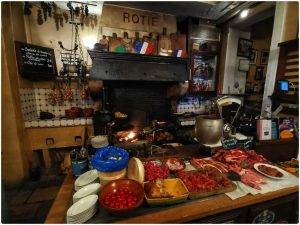 - This restaurant in Bordeaux city itself serves amazing steaks! There is an open kitchen with an wood fire in the main hall where your steak (or meats) are been cooked; that itself is an amazing sight!
- This restaurant in Bordeaux city itself serves amazing steaks! There is an open kitchen with an wood fire in the main hall where your steak (or meats) are been cooked; that itself is an amazing sight! - Le Comptoir de Sèze (map) (Bordeaux) - This restaurant is part of a local hotel, food is very good and very reasonably priced in a nice setting.
- Restaurant le Lion d'Or (map) (Huat-Medoc) - This little restaurant is in the left-bank of Bordeaux, a must try if you are visiting wineries in the region. You will notice that in the main dining hall there are some cabinets with wine stored inside them, you will then notice that there are some very nice wines there; these wines are actually the wine maker / chateau owner’s wines stored in the restaurant for their personal consumption when they dine in this restaurant. The Chateau name are engraved in small plaques on each of the cabinets! If the restaurant is good enough for the wine maker / chateau owner, I think should be good enough for us!
Additional Information
There are other wine related activities you are trying to, here is what I can suggest to also do whilst in Bordeaux
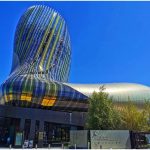 Cité du Vin (map) (Bordeaux) - This is the Bordeaux Wine Museum, it is a very futuristic building in the shape of a decanter. Inside you can do a self guided interactive tour which is quite good but you will need to take the time to listen and absorb. You can also enrol to do a short wine tasting course which includes history and background of Bordeaux. On the top floor is a wine bar, where you can get a glass of wine or two and enjoy the speculator views of Bordeaux.
Cité du Vin (map) (Bordeaux) - This is the Bordeaux Wine Museum, it is a very futuristic building in the shape of a decanter. Inside you can do a self guided interactive tour which is quite good but you will need to take the time to listen and absorb. You can also enrol to do a short wine tasting course which includes history and background of Bordeaux. On the top floor is a wine bar, where you can get a glass of wine or two and enjoy the speculator views of Bordeaux.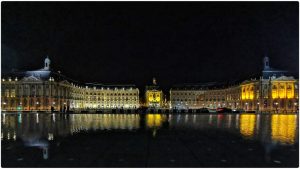 Explore Bordeaux city itself, it is a beautiful walkable city; you can spend a good half day just walking around the small cobbler stone streets exploring; and the view from the famous riverfront is amazing
Explore Bordeaux city itself, it is a beautiful walkable city; you can spend a good half day just walking around the small cobbler stone streets exploring; and the view from the famous riverfront is amazing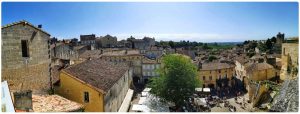 Saint-Émilion (map) (Saint-Émilion) - Besides Bordeaux city, also travel to the small town of Saint-Émilion, it is a beautiful medieval city; there are some cellar doors there too and a great base to get some lunch between winery visits when in Saint-Émilion. The tourist office of Office de Tourisme du Grand Saint-Émilionnais is also located here. The classification of the Saint-Émilion changes every 10 years or so, I usually just simply search online for what is the list of wines in each classification such as on wikipedia
Saint-Émilion (map) (Saint-Émilion) - Besides Bordeaux city, also travel to the small town of Saint-Émilion, it is a beautiful medieval city; there are some cellar doors there too and a great base to get some lunch between winery visits when in Saint-Émilion. The tourist office of Office de Tourisme du Grand Saint-Émilionnais is also located here. The classification of the Saint-Émilion changes every 10 years or so, I usually just simply search online for what is the list of wines in each classification such as on wikipedia
